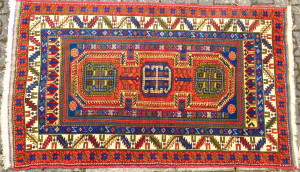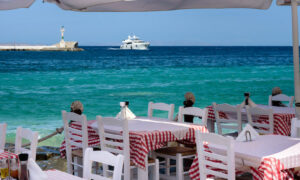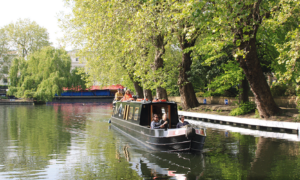BY TERRY BOYD AND CHERYL BOYD
(Editor’s note: Our expat lives circa 2000 were one big shopping trip and we haunted rug shops in Izmir’s ancient caravansarai and the fabulous antiques market in Tongeren, Belgium in search of the beautiful, unique and affordable souvenirs of our crazy travels. This post was the first test content on the Dispatch beta back in 2016. It’s reposted here with updates as we look forward to resuming our post-pandemic travels … and shopping. Please note some of these markets have been suspended during the pandemic.)
If there is one element of expat life in Europe we can single out as most rewarding, it’s proximity: Proximity to the world’s greatest cities and all they offer, especially art and culture.
Art and culture are so important to us we want to literally own them in the form of antiques and collectibles. Which meant we spent way too many weekends at antiques markets and flea markets across Europe, from Metz in France to Ankara, Turkey. And when friends and family visited from the U.S. or Turkey, the first place we took them was to our “secret” treasure troves. Of the few actually valuable antiques we have, a significant number came from the Tongeren Antique Market in Belgium, one of the largest and best-known weekend antiques markets. But the antique furniture and rugs we love the most came from Homburg in Germany, just a few minutes up the A6 Autobahn from where we lived in southwestern Germany near the U.S. military communities in Baumholder, Kaiserslautern, Ramstein and Landstuhl.
So we’ve been meaning to craft a post sharing our tips about what to expect at the best markets we frequented.
Homburg, Germany
(Editor’s note: We’re talking about the Homburg in Saarland south of Frankfurt, not the Homberg north of Frankfurt near Kessel in the state of Hesse. In Germany, multiple cities share the same name, so you have to double-check where you’re going.)
Homburg, unlike Tongeren, is what’s known in German as “flohmarkt” … a flea market, not 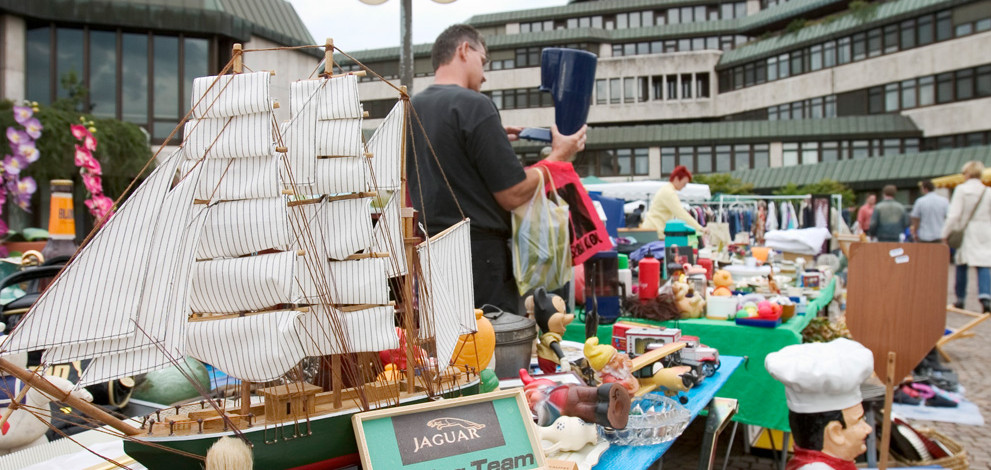 an antiques market.
an antiques market.
Homburg is a really, really big flea market, extending over a several acres in the heart of town, and we typically spent at least two, and sometimes three, hours going booth to booth. Because it’s a flea market, the prices in this unremarkable German town are far more reasonable than at the big antiques markets in major cities such as Paris and Brussels. But here’s a little secret: There isn’t competition at Homburg because there are lot of people passing through who don’t know from nice, to use a Jewish-ism. And in aggregate, we bought far more great pieces here than in the far better-known Tongeren market.
Here’s an example: While living in Turkey, we caught the “rug bug” and became pretty knowledgeable about Turkish carpets. When we moved to Germany, we found a large Turkish population and started to see Turkish carpets show up at flohmarkts. Most were either priced too high for our frugal budgets or were not at all what we liked. We did find a fabulous antique carpet with natural dyes at the Homburg Flohmarkt toward the end of of the day when dealers are anxious to unload inventory rather than have to reload it onto their trucks.
We became well versed in bargaining in Turkey and speak Turkish, so we approached the rug vendor to ask how much the carpet was. He was Turkish. We were speaking Turkish, yet he insisted on answering in German, a language we don’t speak fluently enough for dickering. I guess he couldn’t reconcile Americans haggling in Turkish over a Turkish carpet in Germany.
Our price: We bought the carpet for 140 euros, or about $170 at the time with the exchange rate. It’s not a Turkish carpet, but one from the Caucus Mountains called a Sewan Kazak. We loved it because it’s dark orange, deep cobalt blue and dark red. When we moved back to Louisville, we based our kitchen colors on this carpet.
Estimated value: We believe we could sell it fairly quickly for $2,000, but a Sewan Kazak recently sold at Sotheby’s for 6,000 Pounds Sterling, or about $8,500, a piece not as intricate as ours.
Our other favorite piece also came from Homburg … a 200-year-old French bread table. You can see a nearly identical piece here on 1stdibs.com.
Our price: 200 euros, or about $250 at the time.
Estimated value: You too can own one … for $3,000 (plus $249 shipping). The 1stdibs.com website dates it at 1800-1849, which is in line with what the dealer told us. So, our bread box/table is about 200 years old. We use it as a serving piece in our dining room with table linens and holiday linens stowed underneath.
 We also found this Swat Valley dowry chest from Pakistan at the Homburg Flohmarkt. We bought it, again at the end of the day, for about 75 euros, or about $95. It weighs a ton, and I remember Terry and our friend Scott wrangling it up the stairs (with a turn) in our very old German house. It’s a wonderful conversation piece, sturdy as hell and stores a lot of clothes (my husband, the clothes horse). – Cheryl Boyd
We also found this Swat Valley dowry chest from Pakistan at the Homburg Flohmarkt. We bought it, again at the end of the day, for about 75 euros, or about $95. It weighs a ton, and I remember Terry and our friend Scott wrangling it up the stairs (with a turn) in our very old German house. It’s a wonderful conversation piece, sturdy as hell and stores a lot of clothes (my husband, the clothes horse). – Cheryl Boyd
Our price: 75 euros
Estimated value: I found comparable pieces online priced anywhere from $600 to $4,800.
Where is the Homburg Flohmarkt?
Am Forum 6, 66424, Homburg
Homberg is about 30 minutes southwest of Kaiserslautern in southwest Germany
The market is year round, and is held on the first Saturday of every month in the Forum area in front of town hall from 8 a.m. to 4 p.m.
There are some food and drink trucks, and Homberg has a good mix of antiques dealers with finer items plus some new items and people simply selling things.
Our Tips: The thing about Homburg is you should either arrive very early to get first pick at the great pieces or be there toward the end to get the final deals. One of the things I wanted to buy before leaving Germany was a wood German sled. There were many to be had there, and I picked one up for 5 euros. When everyone packs up for the day, if there are items they don’t want to haul back, they pile them in a nearby area. I picked up a second sled from the “donated” pile, so essentially paid 2.50 euro for each sled. At Christmas I use them to decorate the porch. In summer, I use them on the porch to elevate plants.
Just know that you don’t really go to Homberg with anything in particular in mind. With the exception of getting the wood sleds, which I saw in abundance every time we went, we arrived at different times of the day and nearly always came away with something. We loved Tongeren because of the vastness of the market, lounging over Belgian waffles before the market and the feel of the town. But the truth is, we got the best antiques at the best price at Homburg, only 45 minutes from Heimbach where we lived.
Take small change as it’s hard to get small money Europe-wide especially if you arrive early and there aren’t sales to break a large bill.
Tongeren, Belgium
In all the years we lived in Turkey and Germany, we never found another market to rival the Tongeren Antiques Market in Belgium for sheer scale. There are booths up and down streets through the centrum. More stuff than you can ever imagine from French WWII uniforms to very expensive furnishings and everything in between. Dealers tend to specialize, so you see a full booth of nothing but old glassware, silverware, Dutch tiles, bad art or crazy furniture. That said, there are more quality items than you typically see at these things. Take for example our Golden Goddess on the right. True to form, the vendor we bought her from had nothing but stone heads cut off statues throughout India and Southeast Asia.
Take for example our Golden Goddess on the right. True to form, the vendor we bought her from had nothing but stone heads cut off statues throughout India and Southeast Asia.
The Golden Goddess was caked in mud when I saw her in a big auditorium that’s part of the market. So it took me a while to figure out that in addition to being covered with gold foil, she is wearing an elaborately carved headdress that had been red a few centuries ago, sitting atop a blue sash. The problem was, she’s 12-inches tall and weighs in at about 50 pounds, so we weren’t going to be carrying her around with us as we toured the market. We agreed to the price and gave the vendor a few bucks to hold her. – Terry Boyd
Our price: Not only did we buy the Golden Goddess, the guy threw in a second uninspired carved Buddha head that weighs 30 pounds. So, we bought 80 pounds of carved stone for 60 euros.
Estimate value: No clue. Of all the stuff we’ve bought over the years, the Golden Goddess remains a mystery. If we had to guess, probably not much. Though you have to wonder who went to the trouble to drag a muddy, 50-pound carved stone head back to Tongeren from wherever.
The market is held every Sunday morning throughout the year, sprawling over several blocks from the entrance of the old city wall on the edge of the town to the center of Tongeren. There is a ton of stuff, so it’s best to arrive as early as possible because everything shuts down at noon.
Where is Tongeren? Tongeren is a standout market just on its geography, about 50 miles east of Brussels. It’s on the border with the Netherlands, less than 10 miles from Maastricht, which makes a great side trip. Tongeren is only about 60 miles from Cologne/Bonn/Dusseldorf megaplex and 100 miles from Frankfurt.
What else is there to do:
Lots of good restaurants as well as small cafes where you can get authentic Belgian waffles.
A word to the wise: Don’t do what I did over and over … see something I wanted, but waited to buy in case there was something even better out there. On one trip, I spotted a drawing by early 20th Century Belgian artist Leo Gestel for maybe 100 euros. I thought, “No one is going to know what that is” and keep browsing. So, so dumb because everyone at this market knew more than me, and everyone knows quality when they see it. I went back after 10 minutes, and it was gone. Just buy it …– Terry Boyd
Alacati, Turkey

This is probably the greatest single day of antiquing we ever spent. The Turkish resort town of Alaçati, which is on the Aegean Sea about 45 minutes south of Izmir, is a premier destination for windsurfers from all over Europe. It’s also chock full of incredibly expensive hotels and a few upscale beach resorts where you pay a daily fee for space on the sand and other amenities. And don’t tell anyone else this, but it has one of the greatest weekly antique markets we’ve ever visited.
We probably bought more great items in the shortest amount of time in all the years we’ve been scrounging for antiques. Our total take included an authentic Greek amphora, a nifty paint-on-glass celebration of the Turkish republic, probably done in the 1930s, a small Afghan table, Turkish slippers with the upturned toes and woven with actual silver thread. We could have gotten a marble cesme (sort of an ornate fountain) had it not weighed in somewhere around 250 pounds. Then, we had to figure out some way to ship it back to Germany, where we were living at the time. And we spent a total of about $75. What a day.
What’s it all worth? No one but us would even want this stuff. But we see all those items each and every day, so for us, it’s like that VISA ad: Priceless.
What else is there to do: Plenty. This is one of Turkey’s chicest resorts. Great hotels on a beautiful, windswept stretch of the Aegean where they party till dawn. Hang around and enjoy life.
Antiekcentrum, Amsterdam (previously de Looier)
This isn’t a market at all, but an American-style antique mall in several buildings on one of the outer rings of Amsterdam. Unlike Homberg and Tongeren, this isn’t a bargain hunter’s destination. The dealers here for the most part have top-rung furnishings and collectibles. Are there bargains? You bet … and we have some 19th Century Indonesian shadow puppets from Jakarta to prove it. We bought three puppets for 40 euros per piece, unframed. They’re made of buffalo leather, 100-plus years old. At one time, they were brightly painted, but that paint has faded with time.
Where is the Antiekcentrum? Elandsgracht 109, 1016 TT Amsterdam. The phone number is Country Code 31 – 20-624 -90 38.
By tram: Lines 7, 10, 17 & 20; exit on the stop Elandsgracht. If you arrive from Leidseplein you will see Antiekcentrum Amsterdam on your right across the canal, if you arrive from the Dam or out of the center, you will see the market on the left.
QUICK HITS:
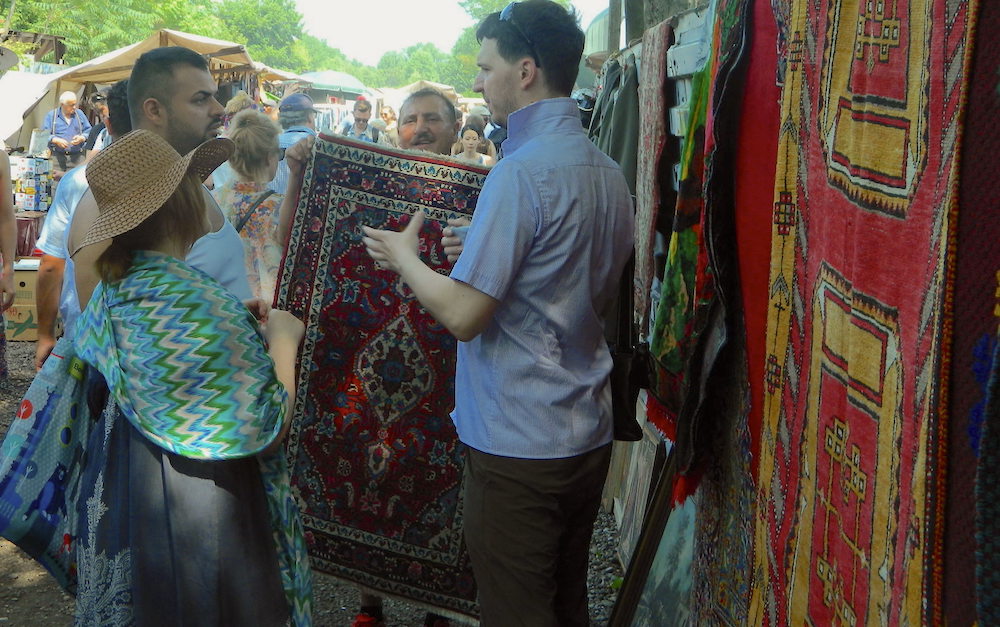 FLOHMARKT IM MAUERPARK, BERLIN
FLOHMARKT IM MAUERPARK, BERLIN
This Sunday market in the center of Berlin is huge, taking up an entire park. This is not a place to go looking for the rare and ancient, but more of a fun day out in Berlin. There are a lot of young, hip Berliners touring tee-shirt and vinyl record booths. That said, we did see vendors this summer with pretty nice rugs. Well, okay rugs, with Chinese and Indian carpets mixed in with Bosnian kilims and few Turkish rugs.
The Mauerpark flea market is more of a gathering place than anything, with great food and snack booths. Oh, and of course there is Karaoke. Seriously.
Sunday Afternoon Cult: Karaoke at Mauerpark
The popularity of the flea market at Mauerpark partly stems from the karaoke sessions that take place at the amphitheatre every Sunday afternoon. From spring until autumn the place is packed with a crowd of curious people even before it starts at 3 p.m. So, everyone interested to see the music spectacle organized by Irish Gareth Lennon should step by early.
METZ ANTIQUE MARKET (Marché aux puce)
Metz is a great town in the Alsace region of France, with a very nice Saturday antiques market during the summer. And by great, we mean you’ll see furniture there priced in the thousands of euros. Not a bargain hunter’s paradise. I remember seeing an authentic Louis XVI table complete with ormolu flourishes and inlay. I walked up to it, then gasped involuntarily. It was 6,000 euros. That said, I found some swell crystal millefiori paperweights for 10 euros each.


